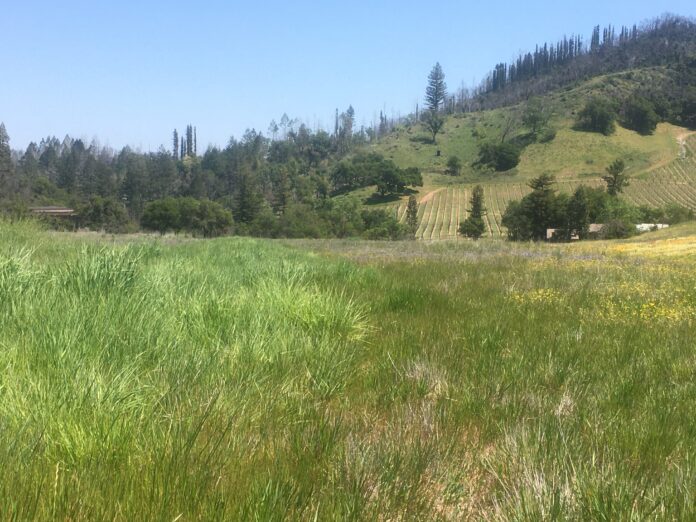When I arrived, in mid April, at Pepperwood Preserve just northeast of Santa Rosa, I saw countless California poppies lining the edges of a long meadow. Michael Gillogly, the preserve manager since 2005 and a worker at the preserve since 1994, greeted me and asked if I wanted to take a closer look.
As we walked into the field of short, green grasses, Gillogly explained that nine native species of grass grow here. But, because of the extremely low amount of rain, the plants were not as lively as they usually are during spring.
“Things are usually a lot taller and more robust [right now]. In April, for it to be dry,” Gillogly said as he kicked a clump of grass, revealing soil already dry to the point of cracking, “that’s almost unheard of.”
With a state drought declaration now covering 49 out of California’s 58 counties, North Bay residents are understandably concerned by the possibility of the dryness adversely affecting the coming wildfire season. According to scientists and conservationists the Bohemian spoke to at Sonoma County’s Pepperwood Preserve, drought conditions don’t guarantee larger fires will occur, but they cause the already-lengthy fire season to stretch on even longer, increasing the chances of fires.
“The fire season is lengthening,” Gillogly told me. “The soil is drying out quicker, and it is because of climate change.”
As places like Sonoma County get warmer, climate change will increase the severity of the dry weather conditions by drying out the soil more quickly, according to the Center for Climate and Energy Solutions (C2ES). It will also change the course of atmospheric rivers, which C2ES says may potentially severely affect the Western United States, further worsening the issue of quickly drying soils.
However, there are many factors that make predicting the scale of the fire season difficult.
“You need three things for a [large] fire,” said David Ackerly, UC Berkeley forest ecology professor and researcher at Pepperwood Preserve.
The first ingredient is fuel. This is readily available each year in our Mediteranean climate, with grasses, native and non-native alike, drying out into the tan husk that makes the hills of Sonoma golden. These dry grasses, and Douglas firs, a conifer commonly found in Sonoma County, make up most of what fuels fires. However, during a very dry year, many trees—such as oaks and bay—in other, more fire-resilient woodlands, can become fire fuel as well.
“As the trees dry out, the twigs lose water and the leaves lose water,” Ackerly said. “They’re literally not as fully hydrated. The more they lose, the more easily they catch on fire.”
Unfortunately, Ackerly explained, there have been no studies looking at how much moisture is lost in oak and bay trees during the dry season.
The second factor is ignition, which can be caused by an ember from a campfire, a misfiring engine, live power lines breaking in strong winds and—sometimes—lightning.
“Last year’s lightning, it was one of those once-a-decade lightning complexes,” Ackerly said. “Other times, obviously, we’re seeing a lot of issues with power lines and the [other] issues we know all too well.”
Strong winds, the final factor in creating large fires, worsen the spread of fire once it ignites. Seasonal winds coming from the Sierra Nevada are called Diablo winds in Northern California; they push fast and dry air currents into the Bay Area and surrounding regions.
A 2020 paper, written by California scientists, states that “the dryness during DWs [Diablo winds] has become more severe with time, especially in October, and possibly leading to an increase in the likelihood of fires and exacerbating the destructiveness of those fires.” This year looks to be no different, with the National Oceanographic and Atmospheric Administration reporting below-average rainfall. When the Diablo winds come, they will likely bring with them a higher chance of large fires, like the Tubbs fire of 2017. That said, it’s important to remember this does not mean a large fire is guaranteed.
As Michael Gillogly and I looked across the meadow at Pepperwood Preserve, I noticed on the top of a small hill a stand of Douglas firs, burnt black, with small shrubs and new bay tree shoots growing up around the dead totems.
“In October it roared right through here,” Gillogly said, referring to the Tubbs fire, which tore through over 90% of Pepperwood Preserve’s 3,117 acres. All told, the fire claimed 22 lives, making it the fourth deadliest fire in California history.
This meadow we stood on was burnt by the flames, along with Pepperwood’s main work building and Gillogly’s house.
We drove to the north end of Pepperwood Preserve. As we walked up to the top of a hill, I looked out to a clear sky over woodlands tucked into the creases of already-drying hills. In 2019, the Kincade fire torched 77,000 acres, including most of the view we saw from Pepperwood Preserve. Firefighters managed to stop the progress of the fire on Pepperwood, using bulldozers in the area where we stood. With the help of many volunteers, Pepperwood managed to fold the top soil back where it was, preserving the native seeds stored in the dirt. I could see no signs of the bulldoze line or other evidence of the fire. It was as though they had disappeared into the landscape.
I asked Gillogly if controlled burns or cattle grazing might help reduce the risks of wildfires. He said yes, we need to do more controlled burns, but also mentioned that, when the conditions are right, there isn’t much humans can do to stop the spread of a raging wildfire.
“The Tubbs fire—nothing would stop that. It crossed six lanes of 101,” he said. “You can’t forest-thin your way out of those kinds of firestorms. Only getting rid of climate change is going to have much of an impact on that.”
When asked what he thought might happen this coming fire season, Gillogly shrugged. “I think we’re gonna have fires,” he said.











